The Next Generation Non Volatile Memory Market is estimated to be valued at USD 1,097.9 million in 2025 and is projected to reach USD 2,348.5 million by 2035, registering a compound annual growth rate (CAGR) of 7.9% over the forecast period.
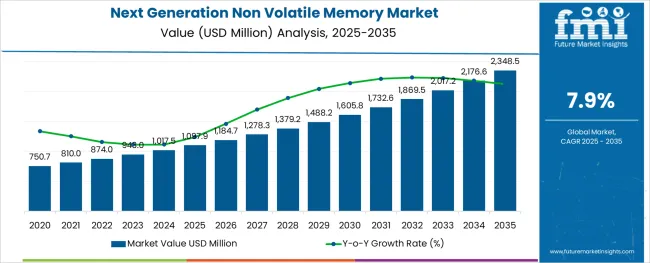
The next generation non volatile memory market is expanding rapidly due to the increasing demand for faster and more reliable data storage solutions. Advances in semiconductor technology and growing data-centric applications have driven the need for memory that retains information without power. Consumer electronics have become a major driver for market growth as devices require efficient memory with low power consumption and high durability.
Technological developments have focused on enhancing memory speed, density, and endurance, supporting a wide range of applications including smartphones, wearable devices, and IoT gadgets. The increasing emphasis on miniaturization and performance optimization in consumer products is expected to further fuel market expansion.
Rising adoption of next generation memory technologies that outperform traditional flash memory is anticipated to support long-term growth. Segmental demand is expected to be led by Non-Volatile Memory as the primary type and Consumer Electronics as the key application sector.
The market is segmented by Type and Application and region. By Type, the market is divided into Non-Volatile Memory and Volatile Memory. In terms of Application, the market is classified into Consumer Electronics, Healthcare Monitoring Applications, Automotive and Transportation Application, Enterprise Storage, Industrial, and Others.
Regionally, the market is classified into North America, Latin America, Western Europe, Eastern Europe, Balkan & Baltic Countries, Russia & Belarus, Central Asia, East Asia, South Asia & Pacific, and the Middle East & Africa.
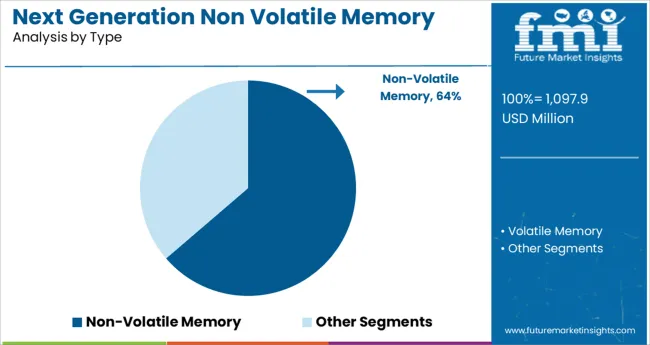
The Non-Volatile Memory segment is projected to hold 63.7% of the market revenue in 2025 maintaining its dominance as the preferred memory type. This segment benefits from its ability to retain data without continuous power supply, which is critical for battery-operated devices. The growing complexity of consumer electronics and demand for instant data access have increased reliance on non-volatile memory.
Advances in technologies such as resistive RAM and phase-change memory have enhanced performance metrics including speed and endurance. The segment’s adaptability across a wide range of device architectures has strengthened its market position.
As consumer demand for faster and more efficient data storage solutions grows, the Non-Volatile Memory segment is expected to continue leading the market.
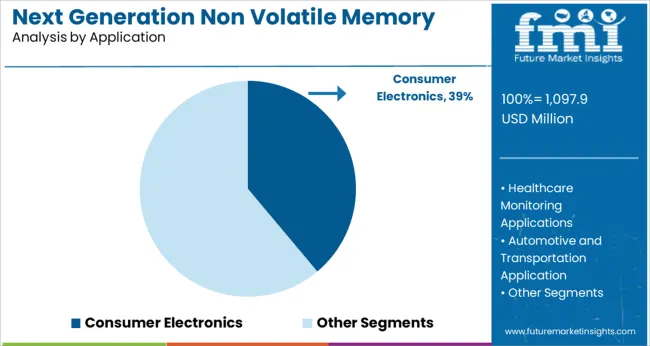
The Consumer Electronics segment is forecasted to contribute 38.9% of the next generation non volatile memory market revenue in 2025 establishing it as the largest application segment. This growth is driven by the proliferation of smart devices that require compact and energy-efficient memory modules. Increasing use of memory-intensive applications such as high-definition video streaming, gaming, and AI-enabled functionalities has escalated memory requirements.
The trend towards portable and wearable devices has underscored the importance of memory that combines high performance with low power consumption.
Consumer demand for enhanced device responsiveness and storage capacity has pushed manufacturers to adopt next generation memory technologies. With ongoing innovation and rising consumer spending on electronics, the Consumer Electronics segment is expected to sustain its market dominance.
Power conservation technologies, along with improved efficiency provided by industry players, surge the sales of next generation non volatile memory.
Growing demand for faster, cost-effective and efficient memory solutions gives rise to the demand for next generation non volatile memory.
Increasing demand and penetration of consumer electronics, leading to flash memory applications in devices, drives the sales of next generation non volatile memory.
The growth of the portable systems market for mass storage applications propels the adoption of next generation non volatile memory.
Due to the increasing electronic gadget market and data storage requirement, consumer demand for advanced memory technologies expands the global next-generation non volatile memory market growth.
Expanding market for tablets and smartphones requires mobile dynamic random access memory (RAM), further bolstering the next-generation non volatile memory market share.
Poor performance and incompatibility of traditional non volatile memory solutions drive the adoption of next generation non volatile memory.
Cloud storage and data centres requiring data storage capabilities increase the demand for next generation non volatile memory.
Improved performance, higher endurance, and lower power consumption contribute to the next generation non volatile memory market growth.
Better scalability with extremely high write endurance further escalates the demand for next generation non volatile memory.
Rising demand for semiconductors is expected to drive the sales of next generation non volatile memory.
Server configurations requiring minimised power budget for memory power management elevates the demand for next generation non volatile memory.
Decreasing profit margins in the traditional memory technologies and advancing the development of new technologies elevates the demand for next generation non volatile memory.
Overall growing demand for mass and universal storage devices for both personal and business usage increases the sales of next generation non volatile memory.
High designing costs for emerging memory solutions curbs the sales of next generation non volatile memory.
Extreme environmental conditions such as high temperature obstruct the next generation non volatile memory market share due to low environmental stability.
The lack of standardised processes set for emerging memory technologies hampers the adoption of next generation non volatile memory.
The improvement of input and output performance of enterprise storage systems for web-based data increases the adoption of next generation non volatile memory.
Increasing demand for wearable and flexible electronics advances the sales of next generation non volatile memory.
The growing requirement of non volatile memory solutions and replacement of flash memory in various applications such as industrial grows the demand for next generation non volatile memory.
The development of the Internet of Things (IoT) with enhanced network connectivity and data transfers propels the next generation non volatile memory market growth.
The popularity of self-owned cars further poses lucrative opportunities for the adoption of next generation non volatile memory.
The improvement in the chip density of NAND memory promises growth of the next generation non volatile memory market share.
The launching of application sectors like a neural networks, industrial applications, and flexible electronics escapes the sales of next generation non volatile memory.
The Asia Pacific is the leading next generation non volatile memory market with a share of 38.1% in 2025.
The presence of key industry participants in China - the world’s second-largest economy, owes to the growth in the global next generation non volatile memory market.
The rising growth of the computer and mobile industry favours the adoption of next generation non volatile memory.
Apart from China, South Korea, Japan, and India are additionally promising growth in the global market.
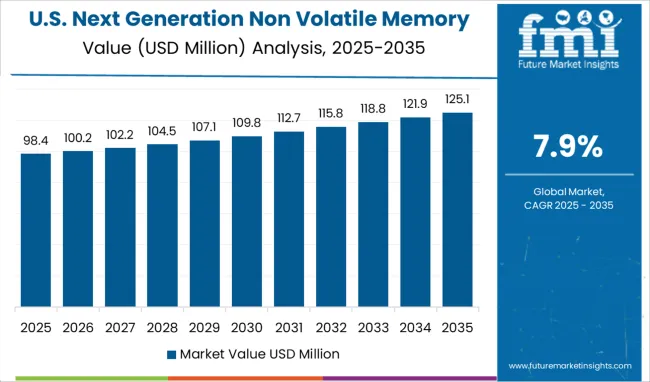
North America is growing fast in the next generation non volatile memory market with a revenue share of 33.3% in 2025.
Rising industrialisation and the market saturated with smartphones and tablet users surge the demand for next generation non volatile memory, in this region.
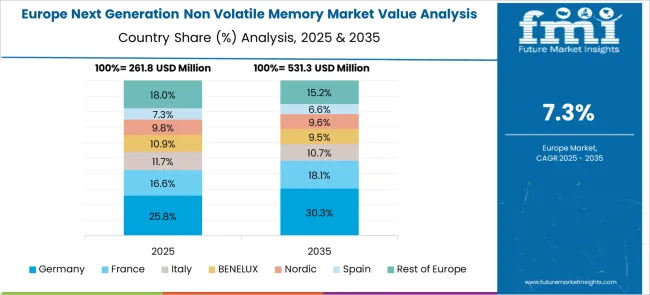
Europe contributes to the next generation non volatile market size with a revenue share of 20.3% in 2025.
Lucrative growth opportunities for the regions in Western Europe owes to the revolution of IT and data centers.
Demand for next generation non volatile memory in this region is further attributed to high demand of impeccable network and high data storage capacity in both personal and business sectors.
The latest technology trends are revolutionising the next generation non volatile memory owing to its scalability, rapid read and write performance and simple structure.
The ability to store data permanently or temporarily and retrieve it at any time is a recurring demand amongst consumers.
Certain start-up companies strive to bring new innovations in data transfer and storage to the forefront with the rising usage of smartphones, tablets and other smart devices amongst the population.
Micron, LSI, Adesto, Nimble Storage, SK Hynix, Avalanche Technology, Crossbar, Smart Modular Technologies, Spansion, Nantero, etc. are few of the start-up companies that are contributing significantly to the next generation non volatile memory market with the assistance of strategies such as designing semiconductors and software to accelerate storage and networking, offering memory devices such as DRAM and DRAM modules, ultra-bandwidth solutions, manage NAND, etc.
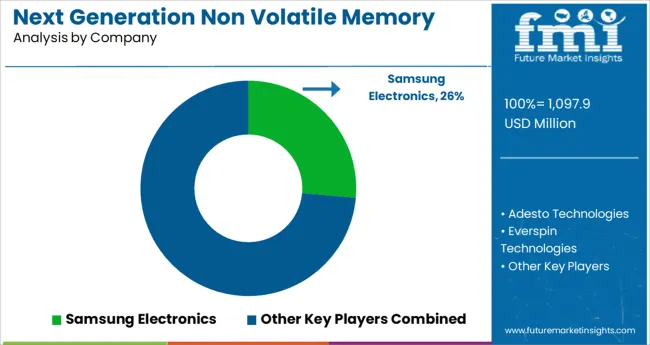
Some of the key market players of the next generation non volatile memory market are Samsung Electronics Co. Ltd, Adesto Technologies, Everspin Technologies, Intel Corporation, Crossbar Inc., Fujitsu Ltd, Micron Technology, Toshiba Corporation, Avalanche Technologies Inc., Everspin Technologies, Inc., Honeywell International Inc. IBM Corp., Infineon Technologies AG, Intel Corporation, Nippon Telegraph and Telephone Corporation ROHM Co. Ltd., Sandisk, SK Hynix Inc., ST Microelectronics NV, Viking Technology, Western Digital Inc., Open-Silicon, Microchip Co., RAMbus, Everspin, Nimble Storage, LSI, Smart Modular Technologies, Spansion, Nantero, etc.
They assist in expanding product offerings in standardised form by introducing R&D activities and strategies that encourage expansion, collaboration, and development with other firms.
| Report Attribute | Details |
|---|---|
| Growth Rate | CAGR of 7.9% from 2025 to 2035 |
| Base year for estimation | 2024 |
| Historical data | 2020 to 2024 |
| Forecast period | 2025 to 2035 |
| Quantitative units | Revenue in USD million and CAGR from 2025 to 2035 |
| Report coverage | Revenue forecast, volume forecast, company ranking, competitive landscape, growth factors, and trends, Pricing Analysis |
| Segments covered | Type, Application, and Region |
| Regional scope | North America; Western Europe; Eastern Europe; Middle East; Africa; ASEAN; South Asia; Rest of Asia; Australia and New Zealand |
| Country scope | USA, Canada, Mexico, Germany, UK, France, Italy, Spain, Russia, Belgium, Poland, Czech Republic, China, India, Japan, Australia, Brazil, Argentina, Colombia, Saudi Arabia, UAE, Iran, South Africa |
| Key companies profiled | Samsung Electronics Co. Ltd; Adesto Technologies; Everspin Technologies; Intel Corporation; Crossbar Inc.; Fujitsu Ltd; Micron Technology; Toshiba Corporation; Avalanche Technologies Inc.; Everspin Technologies, Inc.; Honeywell International Inc. IBM Corp.; Infineon Technologies AG; Intel Corporation; Nippon Telegraph and Telephone Corporation ROHM Co. Ltd.; Sandisk; SK Hynix Inc.; ST Microelectronics NV; Viking Technology; Western Digital Inc.; Open-Silicon; Microchip Co.; RAMbus; Everspin; Nimble Storage; LSI; Smart Modular Technologies; Spansion; Nantero; etc. |
| Customization scope | Free report customization (equivalent to up to 8 analysts working days) with purchase. Addition or alteration to country, regional & segment scope. |
| Pricing and purchase options | Avail customized purchase options to meet your exact research needs. |
The global next generation non volatile memory market is estimated to be valued at USD 1,097.9 million in 2025.
It is projected to reach USD 2,348.5 million by 2035.
The market is expected to grow at a 7.9% CAGR between 2025 and 2035.
The key product types are non-volatile memory and volatile memory.
consumer electronics segment is expected to dominate with a 38.9% industry share in 2025.






Full Research Suite comprises of:
Market outlook & trends analysis
Interviews & case studies
Strategic recommendations
Vendor profiles & capabilities analysis
5-year forecasts
8 regions and 60+ country-level data splits
Market segment data splits
12 months of continuous data updates
DELIVERED AS:
PDF EXCEL ONLINE
Next-Gen Digital Cockpit Solution Market Size and Share Forecast Outlook 2025 to 2035
Next-gen Military Avionics Market Size and Share Forecast Outlook 2025 to 2035
Next-Gen Firewall Market Size and Share Forecast Outlook 2025 to 2035
Next Generation Telehealth Market Size and Share Forecast Outlook 2025 to 2035
Next-generation neurofeedback device Market Size and Share Forecast Outlook 2025 to 2035
Next Generation Cancer Diagnostics Market Size and Share Forecast Outlook 2025 to 2035
Next Generation Solar Cell Market Size and Share Forecast Outlook 2025 to 2035
Next-Generation Intrusion Prevention System (NGIPS) Market Size and Share Forecast Outlook 2025 to 2035
Next Generation Computing Market Size and Share Forecast Outlook 2025 to 2035
Next-Generation Sweeteners Size and Share Forecast Outlook 2025 to 2035
Next Generation Packaging Market Analysis - Size, Share, and Forecast Outlook 2025 to 2035
Next Generation Optical Biometry Devices Market Size and Share Forecast Outlook 2025 to 2035
Next Generation Mass Spectrometer Market Size and Share Forecast Outlook 2025 to 2035
Next Generation Wireless Network Market Size and Share Forecast Outlook 2025 to 2035
Next Generation Network (NGN) Equipment Market Size and Share Forecast Outlook 2025 to 2035
Next Generation Infusion Pump Market Size and Share Forecast Outlook 2025 to 2035
Next Generation Molecular Assay Market – Trends & Forecast 2025 to 2035
Next-Generation Biomanufacturing Market - Trends, Innovations & Forecast 2025 to 2035
Next Generation Immunotherapies Market - Innovations & Growth 2025 to 2035
Market Leaders & Share in the Next Generation Packaging Industry

Thank you!
You will receive an email from our Business Development Manager. Please be sure to check your SPAM/JUNK folder too.
Chat With
MaRIA